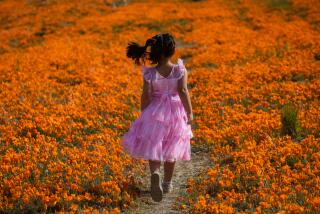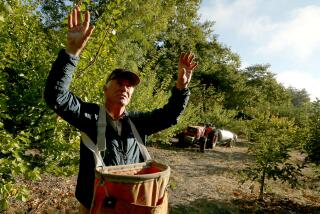Column: California is a sweeping, beautiful mess from 30,000 feet
Nothing pleases me more than hopping on a plane, grabbing a window seat on the right side and gluing my nose to the window as I head north to San Francisco, Santa Rosa, Sacramento or San Jose.
After zipping around the country for the last three presidential campaigns, I now write about California almost exclusively. Most of my flights last less than an hour. I don’t even bother to drink anymore.
Watching the state unfurl from 30,000 feet up is an unrivaled pleasure. Every flight I take reminds me of a story I’ve told.
Taking off into the west, I can pick out my house near the Venice Pier. A few minutes later, the Malibu Pier, looking like matchsticks, comes into view. Mugu Rock is a pebble at this height, but the runways of the Navy’s Pacific Missile Test Center at Point Mugu are impossible to miss.
The plane turns right over the Santa Monica Mountains, which drop away as the Oxnard Plain’s rich agricultural fields spread out.
North of the Santa Ynez Mountains, past the Los Padres National Forest, the flat expanse of the San Joaquin Valley looms. Sometimes the square crops are punctuated by odd, circular fields.
Those circular crops are the result of a watering technique called center pivot irrigation. Joe Del Bosque, my favorite almond farmer, explained this to me last year. He and I spent a lot of time talking about how farmers are coping with the drought and why almonds became everyone’s favorite scapegoat, a trend that thankfully has come and gone.
Del Bosque stores most of his water in the massive San Luis Reservoir, which is easy to spot from the air because of the way the reservoir and its feeder, the O’Neill Forebay, straddle California 152 near Los Banos. Last summer, the yellow and brown bands around the basin’s perimeter were an alarming reminder of our dwindling water supplies.
When I reached Del Bosque by phone Wednesday, he was on vacation in Spain. For complex market reasons, he said, the price of almonds has dropped from more than $4 a pound to less than $3. Almonds are still more profitable than other crops, but they won’t be if water continues to be scarce.
Unlike row crops, you can’t fallow an almond orchard. The trees require water year round. Del Bosque is hoping for a wet winter, but it has to be the right kind of wet.
“If we get a big snowpack,” he said, “it will be helpful. But if El Niño throws a lot of water to Southern California, it’s not going to help us a bit because it all goes to the ocean.”
One of the great joys of flying into Santa Rosa — besides the heroic-size statues of Charlie Brown and Linus that greet you at the entrance of the Charles M. Schulz-Sonoma County Airport — is the view of San Francisco and the Golden Gate Bridge. Alaska Airlines’ prop planes into Santa Rosa fly lower than jets, so the views of California’s famous landmarks are that much better.
San Francisco is spectacular from the air, but on the ground it’s another story. The Golden Age of Tech is remaking the city, driving out the poor and middle class. Homelessness is up, and the streets of the Tenderloin are a sad, urine-soaked mess. Winter, at least, has brought some relief.
“After it rains it always smells better here,” said Stuart Schuffman, a.k.a. Broke-Ass Stuart, who lost a bid for mayor in November.
In February, the Super Bowl is coming to sleepy Santa Clara, an hour south, which means San Francisco will be home base for many attendees. San Francisco Mayor Ed Lee declared that homeless people who sleep along the Embarcadero, the site of many game-related festivities, “are going to have to leave the street.”
For Schuffman, the remark encapsulated the city’s tension between rich and poor. “The mayor says, ‘Homeless people, you have to go’ so that the NFL can have a party? There is so much greed here, and it’s ruining the city.”
I’ve never flown far enough north to spot any illegal marijuana crops in the forests of the Emerald Triangle — Mendocino, Humboldt and Trinity counties, where the finest marijuana in the world is grown — but I anticipate spending a lot of time there this year. Right now, California marijuana may be cultivated and sold only for medical purposes, but when a measure to legalize it for adults hits the ballot next November (and passes, as I believe it will), the impact on our state’s economy, politics and law enforcement will be considerable.
When I fly south, I love picking out California’s coastal communities from the air. On the north end of Monterey Bay, Santa Cruz sits in splendid isolation. A group of its fierce, educated mothers helped lead an unsuccessful battle last summer in Sacramento against mandatory childhood vaccines. I loved visiting with them but was not convinced that vaccines should be a personal choice. Thankfully, the measure was signed into law by Gov. Jerry Brown. It will ensure that most California children come to school protected against childhood illnesses like measles, and mumps, pertussis and polio.
In coastal San Luis Obispo County, Morro Rock is unmistakable. It was near that big volcanic plug in late August that surfer Elinor Dempsey had an encounter with a great white shark. The creature took a big half-moon bite out of her board, and Dempsey, for lack of a better phrase, is still processing the event.

“I go between totally grateful and can’t-believe-it-happened-to-me,” she said from her Los Osos home Wednesday. “It’s surreal. The fact that the shark did not bite me and bit the board instead is completely a miracle. If the shark had bitten me, I would have bled out. The shark’s mouth is as big as my body. I feel completely lucky to be alive.”
I can’t think of better words to end on than Dempsey’s.
Every time I fly over this amazing, inspiring state, I feel lucky to be alive.
Don’t you?
Twitter: @AbcarianLAT
More to Read
Start your day right
Sign up for Essential California for news, features and recommendations from the L.A. Times and beyond in your inbox six days a week.
You may occasionally receive promotional content from the Los Angeles Times.







